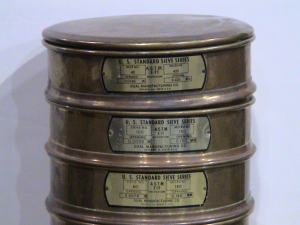If a particular size media is specified for your grit-blasting process, how can you determine if a shipment of brand new abrasive blasting grit is sized correctly for the work? What does the number mean in an abrasive grain designation, such as #80 aluminum oxide?
 Let’s begin by looking at industry standards for grit sizing. The 3 largest abrasive producer groups are the UAMA, the Unified Abrasives Manufacturer’s Association in the U.S.A. (www.uama.org), FEPA, the Federation of European Producers of Abrasives (www.fepa-abrasives.org) and JIS, the Japanese Standardization Organization. All the producers have harmonized on size requirements identical to ANSI, the American National Standards Institute. ANSI B74.12-2001 and FEPA 43GB-1984R1991 and JIS R6001-1987 do not differ on any of the grit sizes defined, but FEPA includes 2 sizes not defined by ANSI or JIS, and JIS does not include 4 macrogrit sizes that are defined by ANSI and FEPA.
Let’s begin by looking at industry standards for grit sizing. The 3 largest abrasive producer groups are the UAMA, the Unified Abrasives Manufacturer’s Association in the U.S.A. (www.uama.org), FEPA, the Federation of European Producers of Abrasives (www.fepa-abrasives.org) and JIS, the Japanese Standardization Organization. All the producers have harmonized on size requirements identical to ANSI, the American National Standards Institute. ANSI B74.12-2001 and FEPA 43GB-1984R1991 and JIS R6001-1987 do not differ on any of the grit sizes defined, but FEPA includes 2 sizes not defined by ANSI or JIS, and JIS does not include 4 macrogrit sizes that are defined by ANSI and FEPA.
Standard Particle Size Distribution
Grit sizing specifications are based on the agreed-upon particle size distribution for each screen or mesh size. Certified or Inspection Test Sieves each bear a number that corresponds to a size in the U.S. Standard Sieve Series with mesh or screen openings as specified by the American Society for Testing and Materials per ASTM E-11.
Lower sieve size numbers mean coarser abrasive particles, and higher numbers designate finer grit. If you are familiar with the grading of sandpaper, the number designations are very similar for grain, bonded and grinding abrasives, so you may already have a feel for the sizing system.
According to ANSI B74.12-2001, for #80 grit abrasive, the following particle size distribution conforms to the standard:
100% pass through Sieve #50
25% maximum retained on Sieve #70
40% minimum retained on Sieve #80
65% minimum retained on Sieve #80 + Sieve #100
3% maximum pass through Sieve #120
Alright, that is what you can expect for brand new media, right out of the bag, but what about the used media in your blast cabinet?
The Operating Media Mix
It is normal for a few media particles to fracture during blasting. Excessively high blast pressures increase the attrition rate, but in a cabinet-blast machine that reclaims and recirculates the media, it is predictable that the percentage of fractional particles (fractured one or more times) will gradually increase, and the number of full size particles will gradually decrease, unless new grit is added.
Abrasive media that have very high fracture rates are usually not recommended for cabinet blasting. For example, with vitreous slag media marketed for single-use outdoor blasting, as much as 75% of the grit particles fracture or disintegrate on the first impact! Such blast materials may be cheap, but they are not considered suitable for cabinet blasting.
For general cleaning applications, such as rust and paint removal, if the results are judged by visual inspection and no particular surface texture or roughness needs to be produced, there is no obvious problem if the operating mix of media particle sizes includes mostly finer grit. Fracture of media particles might be seen as a good thing, since it produces sharp new cutting edges. An excessive percentage of fractional media particles might not be noticed until it takes a lot longer than usual to get the blasting done, or until dusty operation makes visibility difficult inside the blast cabinet.
The best practices are to add a small amount of new media frequently, and if possible, to adjust the cyclone separator/media reclaimer to pull out all of the dust and some of the smaller fractional media particles, in order to maintain a balanced operating media mix.
Technical Surface Preparation
When the purpose of grit blasting is to produce a specified surface texture, and the results are regularly measured to verify that surface roughness values fall within a narrow range, we at Guyson normally refer to the blast application as technical surface preparation or “precision roughening.” This is an entirely separate category from general cleaning or finishing, and we will take up the subject in a future post to this blog.
If you have found valuable information here, you can sign up as a subscriber and be notified by e-mail when new articles are posted. If you have questions about a particular blast media or a new blasting application, call the Guyson factory toll-free from anywhere in the U.S.A. or Canada at 1-800-228-7894 or send us an e-mail using the Contact Guyson page.



